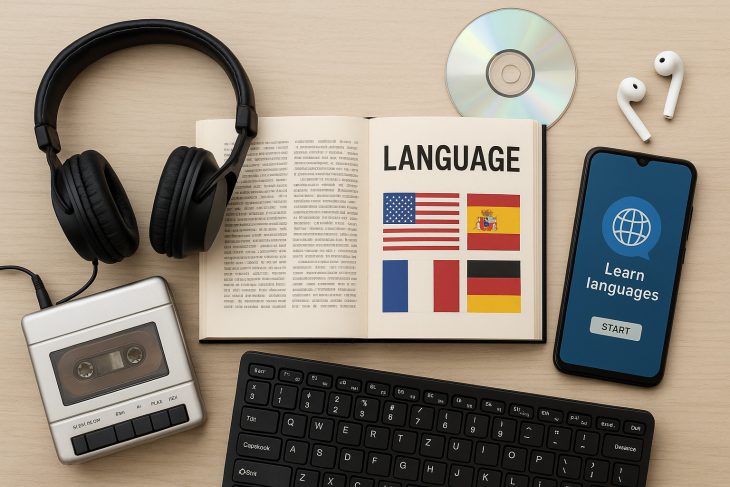
Learning a new language has shifted dramatically from printed books to interactive apps and AI tutors. This list tracks the evolution of language learning tools and highlights how technology has shaped the way people study foreign tongues.
The Early Years: Analog Language Learning
Language learning began with simple tools and gradually expanded into complex technologies.
1. Phonograph records were used for language instruction in the early 1900s.
They played slow, clear pronunciations to help learners imitate sounds.
2. Cassette tape language courses became popular in the 1960s.
Portable players allowed learners to study anywhere.
3. Language laboratories in schools featured reel-to-reel tape systems.
Students repeated words and phrases for pronunciation practice.
4. Self-study language books often came with accompanying audio tapes.
These packages combined reading with listening exercises.
5. Early digital language courses required CD-ROMs.
Users sometimes used an audio converter to transfer lessons from tapes or CDs to digital players.
The Transition to Software and Multimedia
The 1980s and 1990s saw software and interactive CDs gain popularity.
6. Rosetta Stone launched in 1992 with immersive software-based lessons.
It removed translation and focused on visual and auditory context.
7. Encarta’s World Atlas included language samples.
It gave learners short recordings of native speakers.
8. Speech recognition became part of language software by the late 1990s.
Programs began analyzing pronunciation accuracy.
9. Language learning games were introduced for children.
These interactive titles made vocabulary acquisition more engaging.
10. Early handheld electronic translators appeared in the 1980s.
They provided word-to-word translations for travelers and students.
The Internet Age of Language Learning
The internet expanded global access to language resources.
11. Online forums like WordReference started helping learners in 1999.
Users asked native speakers for grammar and translation help.
12. Free language learning websites began to appear in the early 2000s.
Examples include BBC Languages and About.com’s language sections.
13. Streaming services allowed exposure to foreign films and shows.
Subtitles helped learners connect spoken words with text.
14. Podcast-based language courses became popular.
They offered portable lessons, perfect for commuting learners.
15. Skype and video calls enabled real-time language exchanges.
People practiced conversation with native speakers worldwide.
Mobile Apps and On-the-Go Learning
The rise of smartphones changed how languages are studied.
16. Duolingo launched in 2011 as a free gamified learning app.
It gained millions of users for its addictive lesson structure.
17. Memrise introduced memory-enhancing flashcards for vocabulary retention.
It combined spaced repetition with images and mnemonics.
18. Babbel focused on conversational learning for travelers and professionals.
Lessons addressed real-life dialogues and situations.
19. HelloTalk and Tandem apps connected learners directly with native speakers.
Text, voice, and video chats made practice more natural.
20. Anki allowed learners to create custom flashcards with spaced repetition algorithms.
It became a favorite tool for serious language learners.
The Rise of Artificial Intelligence
AI and machine learning brought new possibilities to language education.
21. Google Translate launched in 2006 and now uses neural machine translation.
Its accuracy has improved significantly across hundreds of languages.
22. Chatbots began simulating conversations for practice.
These virtual partners provided safe environments for speaking practice.
23. Voice assistants like Siri and Alexa can now understand and respond in multiple languages.
They offer daily vocabulary and pronunciation practice.
24. AI tutors such as ChatGPT can correct grammar and offer language exercises.
They provide customized feedback based on learner responses.
25. Language learning platforms started offering personalized learning paths.
AI adjusts lesson difficulty based on user progress.
Current Trends and Emerging Innovations
Modern developments are pushing language learning further.
26. Virtual Reality (VR) language apps offer immersive environments.
Users practice dialogues in simulated foreign cities or situations.
27. Augmented Reality (AR) apps translate signs and text in real time.
They aid both travelers and learners on the go.
28. Social media platforms have become informal language classrooms.
Communities on TikTok, Instagram, and Reddit share tips and mini-lessons.
29. Online language tutoring services like iTalki and Preply connect students with teachers.
Flexible pricing and scheduling have made personal tutoring widely accessible.
30. Research into brainwave-responsive language apps is ongoing.
The goal is to adapt learning pace and style based on cognitive feedback.
Looking Ahead: The Future of Language Learning Technologies
Language learning has transformed from rigid, analog systems to highly interactive and personalized digital experiences. From phonograph records to AI-driven tutors, the journey reflects continuous innovation aimed at making language acquisition more accessible and effective for learners of all backgrounds. As technologies like VR, AR, and AI evolve, language learners can expect even more tailored, immersive, and intuitive tools in the years to come.
Was this page helpful?
Our commitment to delivering trustworthy and engaging content is at the heart of what we do. Each fact on our site is contributed by real users like you, bringing a wealth of diverse insights and information. To ensure the highest standards of accuracy and reliability, our dedicated editors meticulously review each submission. This process guarantees that the facts we share are not only fascinating but also credible. Trust in our commitment to quality and authenticity as you explore and learn with us.
